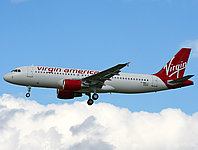The Travel Detective
The New Kid on the Block
For years, many foreign-owned airlines have dreamed of being able to fly not just to America, but throughout America. But they’ve always been blocked by a powerful U.S. airline lobby. After all, if you had a choice of flying American, Delta, United or Singapore Airlines between Los Angeles and New York, it would be a no-brainer. Or San Francisco to Chicago on Cathay Pacific instead of United or American. U.S. airlines claimed it would be unfair competition, their argument being that foreign airlines had lower labor costs and in some cases were subsidized by their governments.
Chances are you’ve heard of Richard Branson, the flamboyant entrepreneur and owner of Virgin Atlantic, the London-based airline. Branson had the same dream.
More than two years ago, he had another idea: Why not start a Virgin-branded carrier for domestic flights in the U.S.? It would be sort of a high-tech, low-cost but more upscale version of Southwest and JetBlue.
One small problem: an existing U.S. law that prohibits a majority ownership of a U.S. airline by a foreign individual or company. Most major U.S. airlines lined up against him, and lobbied hard to prohibit Virgin America from flying within the U.S.
But, little by little, Branson figured a way to comply with U.S. law — having his Virgin group take a 25 percent equity in the company and the rest of Virgin America owned by U.S. investors.
With that obstacle cleared, he was free to finally start the airline. And just a few days ago, at JFK in New York, he did, launching the inaugural Virgin America flight from New York to San Francisco.
It was a gleaming new Airbus 320, only 149 seats, and featuring everything from live TV to mood lighting to onboard Internet chats.
Introductory fares were as low as $149 each way to San Francisco. And $44 between Los Angeles and San Francisco. There’s even a first class section, with no seat being sold for more than $700 on the transcon. (By comparison, first class seats on other airlines flying the route go for as much as $2,200 each way). In just a few days the airline will offer Los Angeles and San Francisco service to Las Vegas.
So, can Virgin America successfully duke it out on the transcon with JetBlue and with Southwest? In the short run, it’s definitely a plus for travelers. Fare wars have already started, and it’s no coincidence that both Southwest and Jet Blue have now announced service to San Francisco (until now, each has only flown to Oakland).
The key, of course, is whether Virgin America can sustain low fares as well as low costs. And, in order for it to succeed, let alone survive, is to build a route network and have frequency. For the moment, at least, Virgin America is the new kid on the block, and deserves the benefit of the doubt. But given the mercurial nature of the airline business, the real issue is capacity, frequency, size of the fleet and other issues that go beyond low fares.
In the short term, a buyers’ market. In the long term, a crap shoot.
Stay tuned.
– P.
For helpful travel web sites, check out our “Travel Resource Links”.













